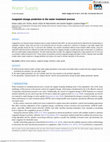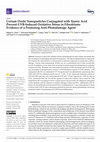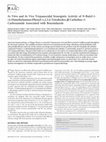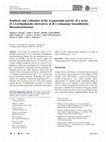Papers by Sueli de Oliveira Silva

Water Supply
Coagulation is an important water treatment step in a water treatment plant (WTP). Jar tests are ... more Coagulation is an important water treatment step in a water treatment plant (WTP). Jar tests are performed to determine the required dose of coagulant; however, these tests are slow to be performed and do not give a response in real-time to changes in raw water quality that changes abruptly during the day. To overcome this limitation, this research developed artificial neural network (ANN) models, using full-scale WTP data that served to calibrate the model and then predict the coagulant dosage, considering raw water as data input, in compliance with the treated water quality parameters. The best model was able to predict the coagulant dosage with a mean squared error of 0.016 and a correlation coefficient equal to 0.872. These results corroborate to promote coagulant dosage automation in WTPs, making it clear that ANN models allow a faster response in dosage definition and reduce the need for human interaction in the process.

Acta Tropica, 2013
The currently available treatments for Chagas disease show limited therapeutic potential and are ... more The currently available treatments for Chagas disease show limited therapeutic potential and are associated with serious side effects. Our group has been attempting to find alternative drugs isolated from natural products as a potential source of pharmacological agents against Trypanosoma cruzi. Here, we demonstrate the antitrypanosomal activity of the amides piperovatine and piperlonguminine isolated from Piper ovatum against epimastigotes and intracellular amastigotes. We also investigated the mechanisms of action of these compounds on extracellular amastigote and epimastigote forms of T. cruzi. These amides showed low toxicity to LLCMK 2 mammalian cells. By using transmission and scanning electron microscopy, we observed that the compounds caused severe alterations in T. cruzi. These alterations were mainly located in plasma membrane and mitochondria. Furthermore, the study of treated parasites labeled with Rh123, PI and MDC corroborate with our TEM data. These mitochondrial dysfunctions induced by the amides might trigger biochemical alterations that lead to cell death. Altogether, our data evidence a possible autophagic process.

Antioxidants
Exposure to ultraviolet radiation induces photodamage towards cellular macromolecules that can pr... more Exposure to ultraviolet radiation induces photodamage towards cellular macromolecules that can progress to photoaging and photocarcinogenesis. The topical administration of compounds that maintain the redox balance in cells presents an alternative approach to combat skin oxidative damage. Cerium oxide nanoparticles (CNPs) can act as antioxidants due to their enzyme-like activity. In addition, a recent study from our group has demonstrated the photoprotective potential of tannic acid (TA). Therefore, this work aimed to synthesize CNPs associated with TA (CNP-TA) and investigate its photoprotective activity in L929 fibroblasts exposed to UVB radiation. CNP conjugation with TA was confirmed by UV–Vis spectra and X-ray photoelectron spectroscopy. Bare CNPs and CNP-TA exhibited particle sizes of ~5 and ~10 nm, superoxide dismutase activity of 3724 and 2021 unit/mg, and a zeta potential of 23 and −19 mV, respectively. CNP-TA showed lower cytotoxicity than free TA and the capacity to reduc...
RSC Advances, 2021
The incorporation of the phthalimide moiety into caffeic acid was decisive for its effectiveness ... more The incorporation of the phthalimide moiety into caffeic acid was decisive for its effectiveness as an NADPH oxidase inhibitor.
Microscopy and Microanalysis, 2020

Pharmaceutical development and technology, Jan 12, 2017
Catabolic conditions like acquired immunodeficiency syndrome, cancer, and burn can cause immunosu... more Catabolic conditions like acquired immunodeficiency syndrome, cancer, and burn can cause immunosuppression. Amino acids such as alanine and glutamine are essential for the activity of the immune system. Propolis is immunostimulant and the waste of propolis extraction has been reused with technological and therapeutic purposes. Therefore, this study describes the association of propolis byproduct extract (BPE) with pectin to prepare spray-dried microparticles containing the dipeptide l-alanyl-l-glutamine as stimulant systems of neutrophils. The use of a factorial design allowed selecting the best formulation, which was characterized by morphology, size, and entrapment efficiency analyses. In addition, the systems were characterized by thermal and X-ray diffraction analysis, Fourier-transform infrared spectroscopy, in vitro drug release, and in vitro cytotoxicity and stimulation test of neutrophils. Small well-structured microparticles with good entrapment efficiency values were achie...

Journal of bioenergetics and biomembranes, Jan 14, 2017
It is becoming increasingly clear that mitochondria drive cellular functions and in vivo phenotyp... more It is becoming increasingly clear that mitochondria drive cellular functions and in vivo phenotypes by directing the production rate and abundance of metabolites that are proposed to function as signaling molecules (Chandel 2015; Selak et al. 2005; Etchegaray and Mostoslavsky 2016). Many of these metabolites are intermediates that make up cellular metabolism, part of which occur in mitochondria (i.e. the TCA and urea cycles), while others are produced "on demand" mainly in response to alterations in the microenvironment in order to participate in the activation of acute adaptive responses (Mills et al. 2016; Go et al. 2010). Reactive oxygen species (ROS) are well suited for the purpose of executing rapid and transient signaling due to their short lived nature (Bae et al. 2011). Hydrogen peroxide (H2O2), in particular, possesses important characteristics including diffusibility and faster reactivity with specific residues such as methionine, cysteine and selenocysteine (Bon...

Oxidative Medicine and Cellular Longevity, 2017
Recently, the cytotoxic effects of apigenin (4′,5,7-trihydroxyflavone), particularly its marked i... more Recently, the cytotoxic effects of apigenin (4′,5,7-trihydroxyflavone), particularly its marked inhibition of cancer cell viability both in vitro and in vivo, have attracted the attention of the anticancer drug discovery field. Despite this, there are few studies of apigenin in cervical cancer, and these studies have mostly been conducted using HeLa cells. To evaluate the possibility of apigenin as a new therapeutic candidate for cervical cancer, we evaluated its cytotoxic effects in a comprehensive panel of human cervical cancer-derived cell lines including HeLa (human papillomavirus/HPV 18-positive), SiHa (HPV 16-positive), CaSki (HPV 16 and HPV 18-positive), and C33A (HPV-negative) cells in comparison to a nontumorigenic spontaneously immortalized human epithelial cell line (HaCaT). Our results demonstrated that apigenin had a selective cytotoxic effect and could induce apoptosis in all cervical cancer cell lines which were positively marked with Annexin V, but not in HaCaT (cont...

Evidence-Based Complementary and Alternative Medicine, 2012
Here we demonstrate the activity of geranylgeraniol, the major bioactive constituent from seeds o... more Here we demonstrate the activity of geranylgeraniol, the major bioactive constituent from seeds ofBixa orellana, againstLeishmania amazonensis. Geranylgeraniol was identified through1H and13C nuclear magnetic resonance imaging and DEPT. The compound inhibited the promastigote and intracellular amastigote forms, with IC50of11±1.0and17.5±0.7 μg/mL, respectively. This compound was also more toxic to parasites than to macrophages and did not cause lysis in human blood cells. Morphological and ultrastructural changes induced by geranylgeraniol were observed in the protozoan by electronic microscopy and included mainly mitochondria alterations and an abnormal chromatin condensation in the nucleus. These alterations were confirmed by Rh 123 and TUNEL assays. Additionally, geranylgeraniol induces an increase in superoxide anion production. Collectively, ourin vitrostudies indicate geranylgeraniol as a selective antileishmanial that appears to be mediated by apoptosis-like cell death.

Cells, 2020
Ion-exchange resins are commonly used to manage complications of chronic kidney disease, such as ... more Ion-exchange resins are commonly used to manage complications of chronic kidney disease, such as hyperphosphatemia, hyperkalemia, and hypercholesterolemia. Occasionally, these drugs can irritate the gastrointestinal lining and cause life-threatening intestinal necrosis. Currently, the pathophysiology of drug crystal-induced intestinal necrosis is not well understood. We hypothesized that crystals of ion-exchange resins like sevelamer, polystyrene sulfonate, and cholestyramine can trigger the formation of neutrophil and monocyte extracellular traps by contributing to intestinal barrier dysfunction. Light and fluorescence microscopy of the colonic resection specimen from a patient with chronic kidney disease revealed severe intestinal necrosis, ulceration, sevelamer crystals, and inflammation upon oral intake of sevelamer, as well as the formation of neutrophil extracellular traps in proximity to small sevelamer crystals. Indeed, drug crystals reduced metabolic activity and induced ba...

Memórias do Instituto Oswaldo Cruz, 2022
Over the past years, natural products have been explored in order to find biological active subst... more Over the past years, natural products have been explored in order to find biological active substances to treat various diseases. Regarding their potential action against parasites such as trypanosomatids, specially Trypanosoma cruzi and Leishmania spp., much advance has been achieved. Extracts and purified molecules of several species from genera Piper, Tanacetum, Porophyllum, and Copaifera have been widely investigated by our research group and exhibited interesting antitrypanosomal and antileishmanial activities. These natural compounds affected different structures in parasites, and we believe that the mitochondrion is a strategic target to induce parasite death. Considering that these trypanosomatids have a unique mitochondrion, this cellular target has been extensively studied aiming to find more selective drugs, since the current treatment of these neglected tropical diseases has some challenges such as high toxicity and prolonged treatment time. Here, we summarise some results obtained with natural products from our research group and we further highlighted some strategies that must be considered to finally develop an effective chemotherapeutic agent against these parasites.
Mechanisms of Ageing and Development, 2020
effect on driving cell survival pathway through inhibition of UVB-induced ROS formation in human ... more effect on driving cell survival pathway through inhibition of UVB-induced ROS formation in human keratinocytes,

Scientific Reports, 2019
Yeast cell wall particles isolated fromSaccharomyces cerevisiae(scYCWPs) have a rich constitution... more Yeast cell wall particles isolated fromSaccharomyces cerevisiae(scYCWPs) have a rich constitution of β-glucan derived from the cell wall. After removing intracellular contents, β-glucan molecules are readily recognized by dectin-1 receptors, present on the cytoplasmic membrane surface of the mononuclear phagocytic cells and internalized.Leishmaniaspp. are obligate intracellular parasites; macrophages are its primary host cells. An experimental murine model of visceral leishmaniasis caused byL. infantumwas used to evaluate the antileishmanial activity of oral administration of these particles. A low-water soluble thiophene previously studiedin vitroagainstL. infantumwas entrapped intoscYCWPs to direct it into the host cell, in order to circumvent the typical pharmacokinetic problems of water-insoluble compounds. We found thatscYCWPs + T6 reduced the parasitic burden in the liver and spleen. There was an increase in IFN-γ levels related to nitric oxide production, explaining the reduc...

Antimicrobial Agents and Chemotherapy, 2011
American trypanosomiasis, or Chagas' disease, is caused by Trypanosoma cruzi and affects arou... more American trypanosomiasis, or Chagas' disease, is caused by Trypanosoma cruzi and affects around 15 million people throughout the American continent. The available treatment is based on two nitroheterocyclic drugs, nifurtimox and benznidazole, both only partially effective and toxic. In this context, new drugs must be found. In our previous work, the tetrahydro-β-carboline compound N -butyl-1-(4-dimethylamino)phenyl-1,2,3,4-tetrahydro-β-carboline-3-carboxamide, named C4, showed a potent in vitro trypanocidal effect. The goal of this study was to evaluate the in vitro and in vivo trypanocidal effects of the compound C4 associated with other drugs (benznidazole, ketoconazole, and amphotericin B). For this, we used the checkerboard technique to analyze the effect of combinations of C4 reference drugs. C4 was assayed in a murine model alone as well as in association with benznidazole. We also evaluated the parasitemia, mortality, weight, and presence of amastigote nests in cardiac ti...

Microbes and infection / Institut Pasteur, Jan 30, 2016
This work evaluated the in vitro and in vivo activity of TDZ 2 on Trypanosoma cruzi amastigotes a... more This work evaluated the in vitro and in vivo activity of TDZ 2 on Trypanosoma cruzi amastigotes and determined the possible mechanism of action of this compound on T. cruzi death. TDZ 2 inhibited T. cruzi proliferation in vitro and had low haemolytic potential. It also induced morphological and ultrastructural alterations. We observed a reduction of cell volume, the depolarization of the mitochondrial membrane, an increase in ROS production, lipoperoxidation of the cell membrane, lipid bodies formation and production of nitric oxide, a decrease in reduced thiols levels and, presence of autophagic vacuoles,. The in vivo study found a reduction of parasitemia in animals treated with TDZ 2 alone or combined with benznidazole. Altogether, the alterations induced by TDZ 2 point to an oxidative stress condition that lead to T. cruzi cell death.
Trypanosomatids are protozoan parasites that have some peculiar characteristics in biological ter... more Trypanosomatids are protozoan parasites that have some peculiar characteristics in biological terms, such as the presence of a single flagellum and kinetoplast (i.e., a specialized organelle that concentrates mitochondrial DNA in the parasite) and alternating forms in vectors and hosts with distinct modes of morphology, biochemistry, and exhaust. Among the diseases caused by trypanosomatids are leishmaniasis and Chagas’ disease, both considered serious public health problems that affect millions of people worldwide. Researchers have prioritized the study of chemotherapeutic agents that act on specific and essential targets in trypanosomatids. These targets include energy metabolism, the trypanothione reductase system, topoisomerases enzymes, arginase, superoxide dismutase, cysteine protease, and the biosynthesis of sterol, microtubules, and polyamines.

Oncogene, 2021
Epidemiologic studies in diabetic patients as well as research in model organisms have indicated ... more Epidemiologic studies in diabetic patients as well as research in model organisms have indicated the potential of metformin as a drug candidate for the treatment of various types of cancer, including breast cancer. To date most of the anti-cancer properties of metformin have, in large part, been attributed either to the inhibition of mitochondrial NADH oxidase complex (Complex I in the electron transport chain) or the activation of AMP-activated kinase (AMPK). However, it is becoming increasingly clear that AMPK activation may be critical to alleviate metabolic and energetic stresses associated with tumor progression suggesting that it may, in fact, attenuate the toxicity of metformin instead of promoting it. Here, we demonstrate that AMPK opposes the detrimental effects of mitochondrial complex I inhibition by enhancing glycolysis at the expense of, and in a manner dependent on, pyruvate availability. We also found that metformin forces cells to rewire their metabolic grid in a manner that depends on AMPK, with AMPK-competent cells upregulating glycolysis and AMPK-deficient cell resorting to ketogenesis. In fact, while the killing effects of metformin were largely rescued by pyruvate in AMPKcompetent cells, AMPK-deficient cells required instead acetoacetate, a product of fatty acid catabolism indicating a switch from sugar to fatty acid metabolism as a central resource for ATP production in these cells. In summary, our results indicate that AMPK activation is not responsible for metformin anticancer activity and may instead alleviate energetic stress by activating glycolysis.

Microscopy and Microanalysis, 2020
Leishmaniasis comprises a group of diseases that are caused by parasites the genus Leishmania, pr... more Leishmaniasis comprises a group of diseases that are caused by parasites the genus Leishmania, presented as a severe public health problem in many countries worldwide, affecting mainly regions that are socially and economically vulnerable [1]. The chemotherapeutic arsenal comprises just three main drugs (pentavalent antimonials, amphotericin B and miltefosine), which exhibit several limitations, including long administration regimens, hospitalization, high costs and severe adverse effects. The search for new drugs therefore remains a necessity, especially for developing countries [2] , however, in order to succeed in the development these new drugs, it is necessary to know all the structural and functional biology of the parasite, for the purpose of identify possible therapeutic targets. In this context, our research group has already shown in previous studies, that the synthetic compound 4-(5'-formyl-[2,2'-bithiophen]-5-yl)but-3-yn-1-yl acetate, ACET-1, induced ultrastructural and morphological changes in promastigotes of Leishmania amazonensis, when treated with IC50 (28.9 µM) for 72 h. Based on this, we propose a strategy to increase the understanding of the mechanism of action of this compound, mainly on the cytoskeleton and plasma membrane of promastigote, and consequently the understanding of the ultrastructure of the parasite, using FIB-SEM techniques and producing a virtual 3D models. For this, promastigote (1 x 10 6 cells ml-1) were treated with IC50 of ACET-1 for 72 h at 28 ºC. After, the parasites were fixed in a solution of 2.5% glutaraldehyde in 0.1 M cacodylate buffer for 24 h at 4 ºC. Past this time, the parasites were post-fixed in a solution of 1% OsO4, 0.8% potassium ferricyanide and 10 mM CaCl2 in 0.1 M cacodylate buffer. The samples were dehydrated in increasing acetone gradient and embedded in Polybed 812 resin. Sputter-coated with gold was performed and the serial sections were obtained using the FIB-SEM double-beam microscope (FEI Scios). The alignment, segmentation and cell rendering was realized by AMIRA (FEI Company, USA). Our results demonstrated that ACET-1 induced morphological and ultrastructural alterations in promastigote at molecular level, destabilizing the protein bonds between the subpelicular microtubules and the plasma membrane resulting in morphological alterations.

Oxidative Medicine and Cellular Longevity, 2019
Chronic UVB exposure promotes oxidative stress, directly causes molecular damage, and induces agi... more Chronic UVB exposure promotes oxidative stress, directly causes molecular damage, and induces aging-related signal transduction, leading to skin photoaging. Dihydrocaffeic acid (DHCA) is a phenolic compound with potential antioxidant capacity and is thus a promising compound for the prevention of UVB-induced skin photodamage. The aim of this study was to evaluate the antioxidant and protective effect of DHCA against oxidative stress, apoptosis, and matrix metalloproteinase (MMP) expression via the mitogen-activated protein kinase (MAPK) signaling pathway on L929 fibroblasts irradiated with UVB. DHCA exhibited high antioxidant capacity on 2,2-diphenyl-1-picrylhydrazyl (DPPH•), 2,2-azinobis-3-ethylbenzothiazoline-6-sulphonic acid (ABTS•+), and xanthine/luminol/xanthine oxidase (XOD) assays and reduced UVB-induced cell death in the neutral red assay. DHCA also modulated oxidative stress by decreasing intracellular reactive oxygen species (ROS) and extracellular hydrogen peroxide (H2O2)...

Medicinal Chemistry Research, 2016
In this study, we synthesized a series of 1,3,4thiadiazole derivatives of R-(?)-limonene benzalde... more In this study, we synthesized a series of 1,3,4thiadiazole derivatives of R-(?)-limonene benzaldehydethiosemicarbazones (2a-k). We also determined the cytotoxicity in LLCMK 2 cells and the activity against epimastigote and trypomastigote forms of Trypanosoma cruzi, of these synthetic compounds and also of a series of 1,3,4thiadiazole without the monoterpene R-(?)-limonene (4ak). 1,3,4-Thiadiazole compounds showed significant trypanocidal activity and a high selectivity indexes. The vast majority of the monoterpene derivatives, substituted by R-(?)-limonene, presented better anti-T. cruzi activity than the non-substituted compounds. Regarding the cytotoxic profile, the compounds without the monoterpene R-(?)limonene were, in general, less toxic. The present findings indicate that the 1,3,4-thiadiazoles derivatives of R-limonene have potential trypanocidal activity that justify further studies to better understand the mechanism of action of these substances on T. cruzi.








Uploads
Papers by Sueli de Oliveira Silva